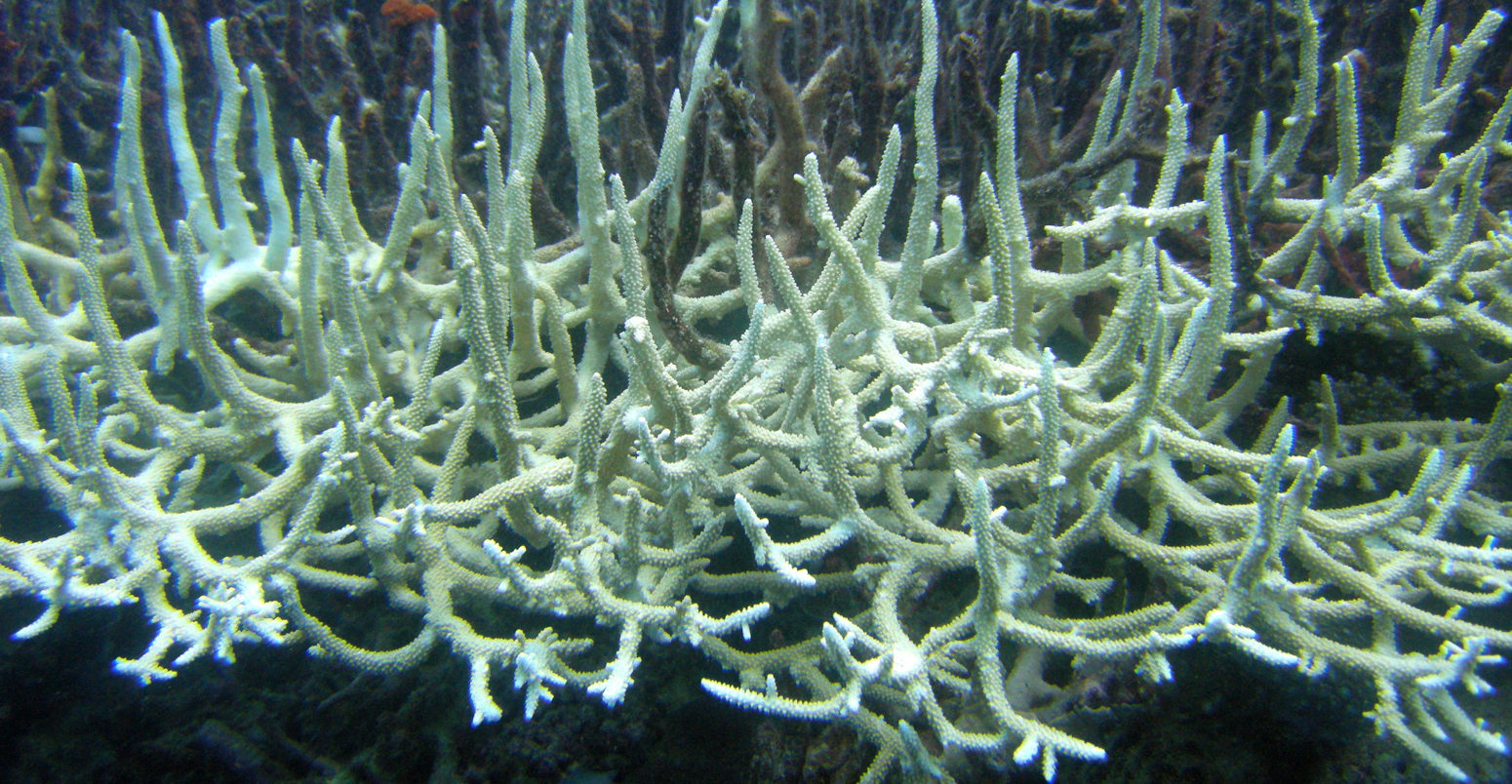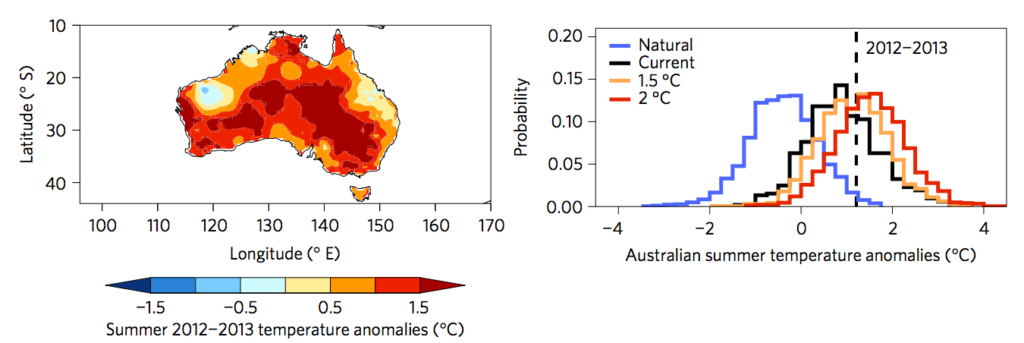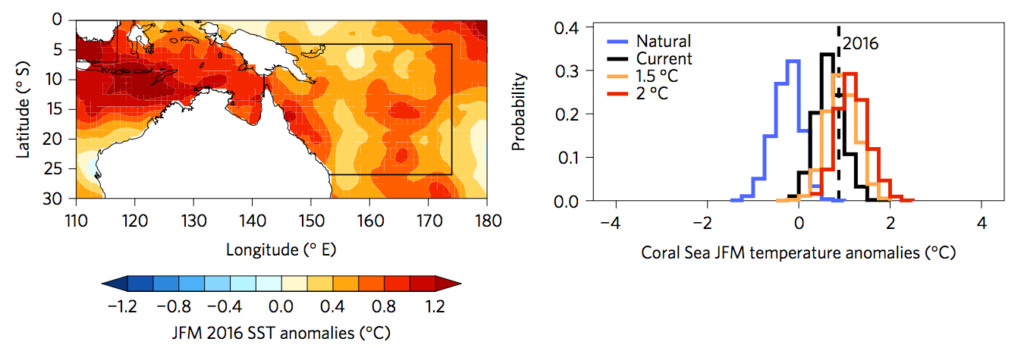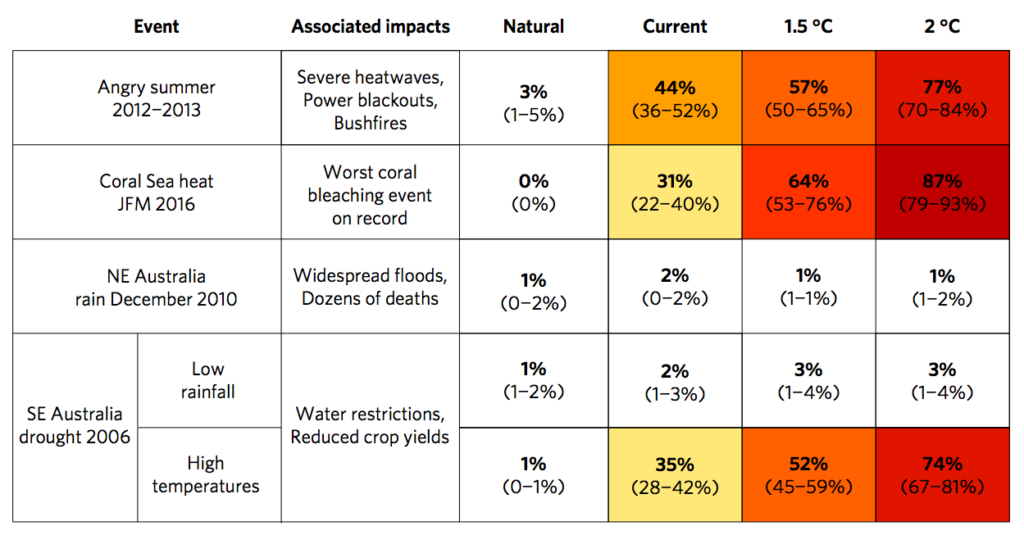
Limiting warming to 1.5C has clear benefits for Australia, study says
Robert McSweeney
05.15.17Robert McSweeney
15.05.2017 | 4:08pmGlobal temperature rise of 2C could see Australia hit by heat extremes similar to the “angry summer” of 2012-13 in almost four out of every five years, a new study says.
The risk is still sizeable at 1.5C of warming, but it lowers to less than three out of every five years.
The research highlights the risks to Australia – and particularly the Great Barrier Reef – of warming beyond 1.5C. Sea surface temperatures as high as 2016, which caused record levels of bleaching on the Great Barrier Reef, could occur in 87% of years in a 2C warmer world, the study warns.
The findings send “a clear message” that Australia will suffer from more heat extremes without substantial action to cut emissions, the lead author tells Carbon Brief.
‘Angry summer’
Australia has been no stranger to extreme weather events in recent years.
The “angry summer” of 2012-13, for example, saw more than 205 records broken, including Sydney’s hottest summer and a record run of 30 days above 30C in Brisbane. In 2016, high sea surface temperatures (SSTs) caused the worst coral bleaching event in the Great Barrier Reef’s recorded history, leaving just 9% of the reef untouched.
The new study, just published by Nature Climate Change, analyses how likely these, and other, extreme events might become under future warming.
The researchers ran a collection of 16 climate models to simulate four different versions of the Earth’s climate: a “natural” world without human influence on the climate; the “current” climate (defined as the average across 2006-26); a world 1.5C warmer than pre-industrial levels; and a world 2C warmer.
In the current climate, for example, the study finds that there is a 44% chance of another “angry summer” in any given year. Previous research has shown that such an event is already at least five times more likely because of human-caused climate change.
Looking ahead, the new study projects the likelihood will increase further to 57% with 1.5C of warming, and to 77% with 2C. That translates into almost four of every five summers in a 2C world being as hot as the summer of 2012-13.
You can see these results in the figure below. The map on the left shows the average temperature across Australia during the 2012-13 summer, compared to the 1961-90 average.
The chart on the right shows the likelihood of hotter summers in all four different climates – natural (blue line), current (black), 1.5C of warming (orange) and 2C of warming (red). The further to the right each jagged curve is, the more often very hot summers are projected to occur. The peak in each line shows the most likely temperature of future summers in each projection.
So, in a 2C warmer world for example, Australian summers will most often be close to 2C warmer than during 1961-90, but could still be 1C cooler or as much as 4C hotter.

Left: Map of observed temperatures (compared to a 1961-90 baseline) during the “angry summer” of 2012-13. Right: Likelihood of hotter summer temperatures in a given year in a “natural” world, the current world, a 1.5C world and a 2C world. The dotted line shows the 2012-13 summer for comparison. Source: King et al. (2017)
‘Little chance of survival’
The figure below shows the equivalent projections for high SSTs in the Coral Sea (the black box in the map), which cause bleaching of the Great Barrier Reef.
Summer SSTs are likely to increase under both 1.5C and 2C of warming, the study finds. While the chances of another 2016 event in a given year is around 31% in the current climate, the researchers project this will rise to 64% under 1.5C, and 87% under 2C.

Left: Map of observed sea surface temperatures (compared to a 1961-90 baseline) during the 2016 coral bleaching event in the Coral Sea (area in the black box). Right: Likelihood of hotter SSTs in the Coral sea (January-March) in a given year in a “natural” world, the current world, a 1.5C world and a 2C world. The dotted line shows the 2016 event for comparison. Source: King et al. (2017)
The results show the risks to Australia – and particularly the Great Barrier Reef – of warming beyond 1.5C, says Dr Carl-Friedrich Schleussner, a scientific advisor at Climate Analytics in Germany. Schleussner wasn’t involved in the research but led a study last year on comparing climate change impacts at 1.5C and 2C. He tells Carbon Brief:
“The impacts of heatwaves in Australia are already very substantial to date and ocean warming has just led to the biggest coral bleaching event at the Great Barrier Reef – one of the world’s most precious ecosystems. The reef will be at high risk already at 1.5C of global warming and at 2C there seems to be little chance for survival.”
Rainfall the ‘noisier’ variable
While the differences in heat extremes between 1.5C and 2C are distinct, the results are less clear for rainfall, the study finds.
Events such as the extremely wet December in Queensland in 2010 would “remain rare” in a 1.5C or 2C warmer world, the paper says, while the drought in southeast Australia in 2006 would become slightly more frequent, but “remain unusual.”
The figure below summarises how the likelihood of recent extreme weather events in Australia are projected to change in future.

Table shows examples of the likelihoods in a given year of similar events to four recent Australian extremes in a “natural” world, the current world, a 1.5C world and a 2C world. The central modelling estimate is shown in bold, with the range in the results shown in brackets. Source: King et al. (2017)
Overall, the “benefits of limiting warming to 1.5C are clearer through the significant and substantial reduction in frequency of heat extremes as opposed to precipitation extremes,” the paper concludes.
This is because rainfall changes can be thought of as more of a secondary response to increasing CO2 emissions, says lead author Dr Andrew King, a climate extremes research fellow at the University of Melbourne. By comparison, temperature changes are a primary response, he explains to Carbon Brief:
“Rainfall is a ‘noisier’ variable than temperature, with high year-to-year variability and changes related to both shifts in weather systems and changes in the availability of moisture.”
That said, droughts may become more likely where only relatively small reductions in rainfall are exacerbated by periods of high temperatures, says King:
“The fact that we found a signal for a higher chance of rainfall deficits in southeast Australia under either 1.5C or 2C warming is concerning. The combination of warmer and drier conditions will pose challenges for agriculture and water supply in the region.”
‘Inadequate’ climate policies
The results show that keeping global temperature rise to 1.5C, rather than 2C, has clear benefits for Australia, says King:
“If global warming can be limited we might avoid some of the very worst impacts of very hot Australian summers – such as heat-related deaths, power blackouts, severe bushfires – and we might be able to protect parts of the Great Barrier Reef from the effects of heat-driven coral bleaching.”
But while the study shows that Australia has much to gain from limiting warming to 1.5C, its current national commitments to reducing CO2 emissions is inadequate, says Schleussner,
“The paper illustrates the substantial benefits of limiting warming to 1.5C for Australia, a country with currently inadequate climate policies to even limit warming to 2C.”
The results should spur greater efforts to prevent the worst impacts of climate change, adds King:
“I think it sends a clear message that Australia will suffer from more climate extremes, especially extreme heat, if substantial action to tackle climate change is not taken.”
King, A. D. et al. (2017) Australian climate extremes at 1.5C and 2C of global warming, Nature Climate Change, doi:10.1038/nclimate3296

